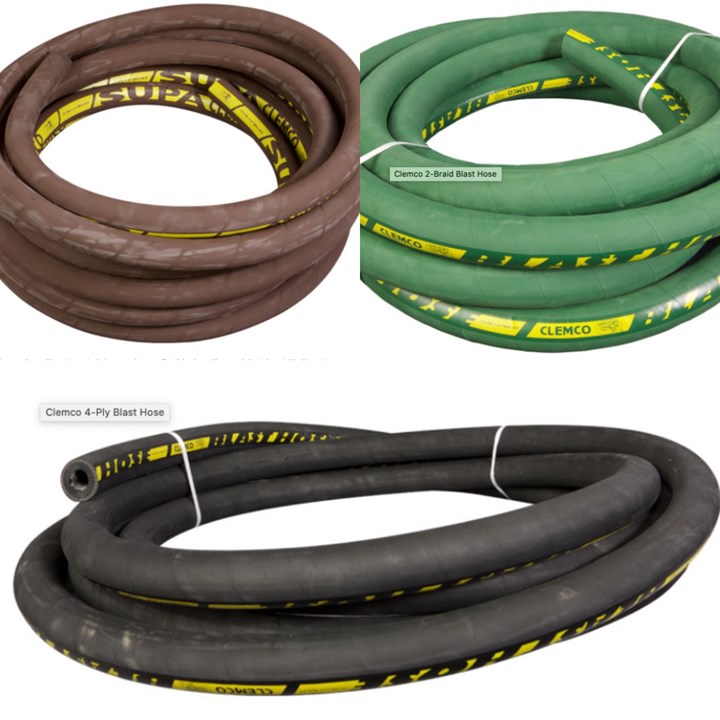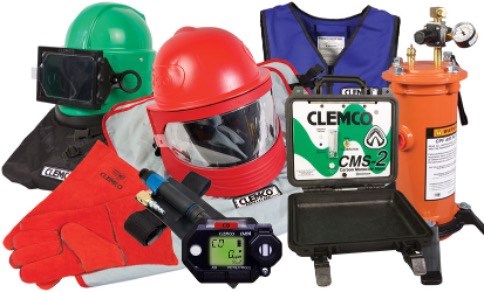Tips for Choosing Abrasive Blasting Safety Equipment and Safety Procedures
Selecting new blasting equipment? Lane Barnholtz of Clemco Industries, manufacturer of air-powered abrasive blasting equipment, offers insights for choosing the correct equipment for your needs.
Q: I’m planning to add blasting capabilities as part of an expansion of my facility. What considerations do I need to keep in mind as I select blasting equipment?
It’s a cliché, but it’s true: To do a job right, you need the right equipment. This is especially true for abrasive blasting.
The information that follows outlines how to evaluate which safety equipment and safety procedures are best for a typical abrasive blasting job. However, before choosing equipment or establishing safety procedures, evaluate the target surface and the worksite environment, perform a job hazard analysis, and assess the goals of the job.
1. Blast Hose and Couplings
Always use an appropriately sized, good quality, static-dissipating blast hose that is manufactured for abrasive blasting and rated at the appropriate working pressure. The blast hose ID should be at least three times the size of the nozzle orifice.

Blast hoses can come in different sizes. A standard hose (top left) is lighter and more flexible than 2-braid (top right) and 4-ply (bottom) hoses, which offer added durability for use in industrial settings where external scuffing is expected.
Photo Credit: Clemco Industries
2. Operator Safety Equipment
Personal protective equipment (PPE), including NIOSH-approved respiratory protection, is necessary for workers using blasting equipment, as well as for everyone in the work area. No dust is safe to breathe! Use an air-fed helmet that not only furnishes breathing air but that also muffles noise, allows an unobstructed field of vision, and protects the operator’s head and face from rebounding abrasive.
Additional operator safety equipment may include air filters, safety cables, couplings, air pumps, light-duty and heavy-duty blast suits, Beacon Blast Lights, screens, supplied-air respirators, and more. Consult your supplier to help assess what you need for safe, comfortable, compliant abrasive blasting,

Operator safety equipment comprises a variety of gear including protective clothing, respirators, air filters and more.
Photo Credit: Clemco Industries
3. Carbon Monoxide Monitor-Alarms
These devices trigger audible, visual and/or vibratory alarms after they detect unsafe levels of carbon monoxide (CO) in the breathing-air supply of a supplied-air respirator. CO can be produced by oil-lubricated compressors or by motor or engine exhaust that enters the intake of a compressor or ambient air pump.
Various types of carbon monoxide monitor-alarms are available from wall-mountable alarms to portable models for use in the field to wearable detectors, such as Clemco’s CMS-4, which is designed to quickly attach inside a respirator helmet and to enable operators to self-monitor their carbon monoxide exposure.
4. Properly Prepared Operators + The Right Equipment = Successful Abrasive Blasting
Just like any other task in life, knowledge, experience, and proper training are essential to abrasive blasting. OSHA regulations state that employers are responsible for training operators and for supplying all necessary PPE. Employers also must establish a safety program and ensure that their workers follow safe practices on every job. OSHA’s regulations reinforce that the best way to guarantee a safe, efficient, and productive abrasive blasting operation is to use properly trained, properly protected operators who have the right equipment for the job.
For more information about efficient and safe abrasive blasting, download the following free eBooks from Clemco Industries:
- Abrasive Blasting Safety Practices
- Blast Off 2
- 3 Tips for Avoiding Poor Blast Machine Performance
Download the eBooks: clemcoindustries.com/free-books
About the Author
Related Content
In-House Blackening of Ferrous and Non-Ferrous Metals
Process satisfies customers’ shipping requirements while meeting stricter water regulations in times of drought.
Read MoreCalifornia Looks to Finalize Rule Phasing Out Hexavalent Chromium Plating Processes
California will hold a public hearing January 27, 2023 on its new state rule to phase out hexavalent chromium plating and anodizing.
Read MoreCleaning, Pretreatment to Meet Medical Specs ISO 13485 or FDA 21 CFR820
Maximilian Kessler from SurTec explains new practices for industrial parts cleaning, metal pretreatment and decorative electroplating in the medical device industry.
Read MoreAnode Answers for Hard Chrome Plating
While problems continue to rise with using lead anodes for hard chrome plating, some manufacturers are discovering platinized titanium anodes as a much-improved alternative with a long list of advantages.
Read MoreRead Next
Powder Coating 4.0: Smarter, Faster, More Efficient and Connected
New tools reduce cost and waste, lower manufacturing footprint of powder coating operations.
Read MoreThe 2024 Ford Mustang: All the Colors Available
Although Chevrolet has announced the end of the Camaro and Dodge is offering “Last Call” editions of the Charger and Challenger, the Ford Mustang is launching to its seventh generation.
Read MoreEpisode 42: An Interview with Robin Deal, Hubbard-Hall
Hubbard-Hall wastewater treatment specialist Robin Deal discusses the latest trends in wastewater management.
Read More











